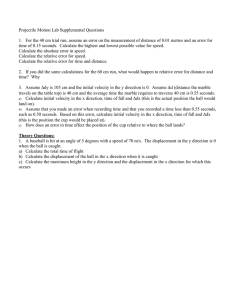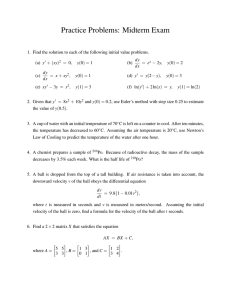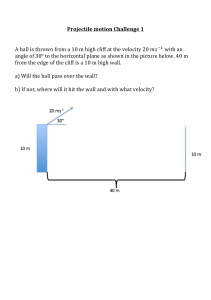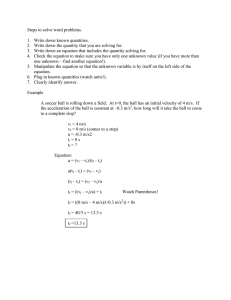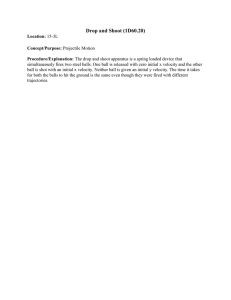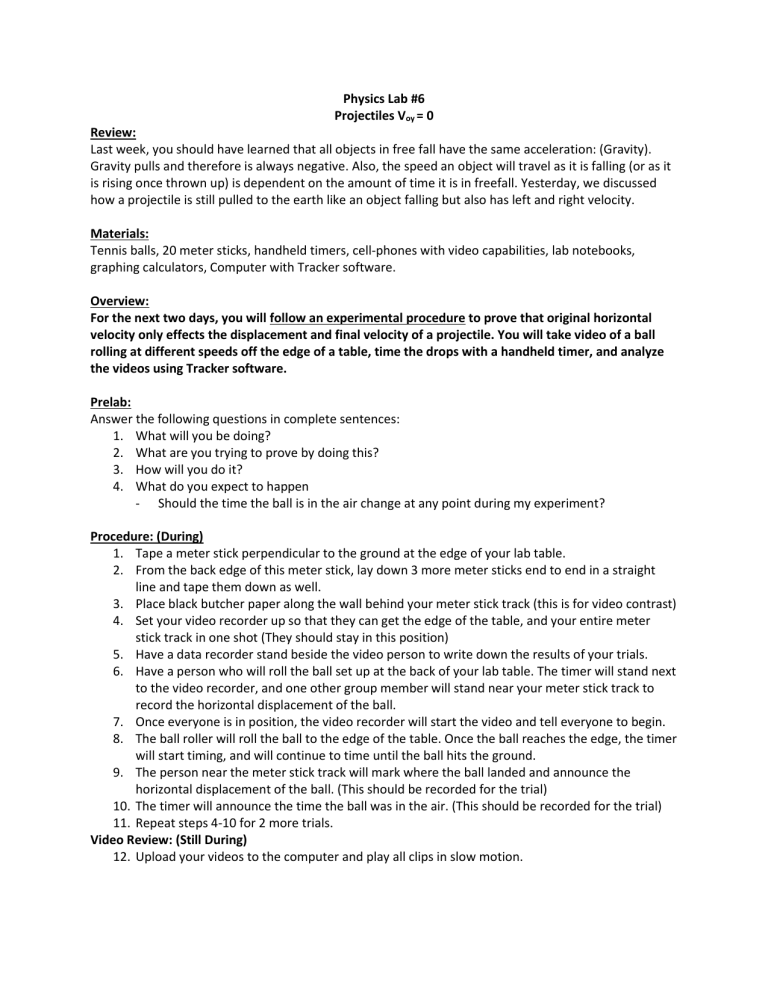
Physics Lab #6 Projectiles Voy = 0 Review: Last week, you should have learned that all objects in free fall have the same acceleration: (Gravity). Gravity pulls and therefore is always negative. Also, the speed an object will travel as it is falling (or as it is rising once thrown up) is dependent on the amount of time it is in freefall. Yesterday, we discussed how a projectile is still pulled to the earth like an object falling but also has left and right velocity. Materials: Tennis balls, 20 meter sticks, handheld timers, cell-phones with video capabilities, lab notebooks, graphing calculators, Computer with Tracker software. Overview: For the next two days, you will follow an experimental procedure to prove that original horizontal velocity only effects the displacement and final velocity of a projectile. You will take video of a ball rolling at different speeds off the edge of a table, time the drops with a handheld timer, and analyze the videos using Tracker software. Prelab: Answer the following questions in complete sentences: 1. What will you be doing? 2. What are you trying to prove by doing this? 3. How will you do it? 4. What do you expect to happen - Should the time the ball is in the air change at any point during my experiment? Procedure: (During) 1. Tape a meter stick perpendicular to the ground at the edge of your lab table. 2. From the back edge of this meter stick, lay down 3 more meter sticks end to end in a straight line and tape them down as well. 3. Place black butcher paper along the wall behind your meter stick track (this is for video contrast) 4. Set your video recorder up so that they can get the edge of the table, and your entire meter stick track in one shot (They should stay in this position) 5. Have a data recorder stand beside the video person to write down the results of your trials. 6. Have a person who will roll the ball set up at the back of your lab table. The timer will stand next to the video recorder, and one other group member will stand near your meter stick track to record the horizontal displacement of the ball. 7. Once everyone is in position, the video recorder will start the video and tell everyone to begin. 8. The ball roller will roll the ball to the edge of the table. Once the ball reaches the edge, the timer will start timing, and will continue to time until the ball hits the ground. 9. The person near the meter stick track will mark where the ball landed and announce the horizontal displacement of the ball. (This should be recorded for the trial) 10. The timer will announce the time the ball was in the air. (This should be recorded for the trial) 11. Repeat steps 4-10 for 2 more trials. Video Review: (Still During) 12. Upload your videos to the computer and play all clips in slow motion. 13. Pause your video right as the ball leaves the table and record the time stamp of the video. Now slowly use slow motion until the ball hits the ground. Calculate the difference in time from the video. - What did you notice about your times in all videos? 14. Watch how the ball leaves the table in all of your videos. - Is there an immediate drop downward or rise upward as soon as it leaves the table? 15. Since there is no immediate rise or drop as soon as the ball leaves the table, we know that Voy =0 so use the displacement formula to find what the time should have been for all trials: D = Vo(T) + .5(A)(T2) 16. Use tracker video analysis to compare the velocity curves for all three of your trials. - What do you notice about the curve of all three trials? Lab Report: I. Heading: Make sure it is on your lab, and it has everyone you worked with on it!!! II. Overview: You must provide an overview in one or 2 sentences explaining what the goal of the lab is, and what you did. Also, give a real world example of how this lab could apply to real life. III. Procedure: I gave you this, so you don’t have to do it. Free 15 points for everyone IV. Variables: You must tell me what at least one control was, What was the independent variable? What was the dependent variable? V. Graphs: You should sketch what the position vs time, and velocity vs time graphs would probably look like for this lab. (Tracker is very useful for this, but give me real data from your experiment) VI. Conclusions: a. Explain your results: Was the time the same, close, or vastly different in each of your trials? Did you have up and Down velocity as soon as your ball left the table? How do you know? Did you have vertical velocity when the ball hit the ground? How do you know? b. What did you learn by doing this experiment: Was there any correlation between time and total ball displacement? Was there a correlation between initial velocity and total displacement? How are my graphs similar to one another, and how are they different? c. How closely did your lab experiment match what you expected to happen and why: Give me details to support why you were right or wrong d. If you had to do this experiment again, what would you change to get better results: What could give you more accurate information? Are there any devices that you could use to track velocity or acceleration? What could you physically do to make your results more accurate in your experiment?


